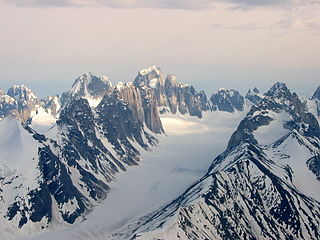
The name of the highest mountain in North America became a subject of dispute in 1975, when the Alaska Legislature asked the U.S. federal government to officially change its name from Mount McKinley to Denali. The mountain had been unofficially named Mount McKinley in 1896 by a gold prospector, and officially by the federal government of the United States in 1917 to commemorate William McKinley, who was President of the United States from 1897 until his assassination in 1901.

Kichatna Spire, sometimes called the Kichatna Spires, is a 7,684-foot (2,342 m) spire-shaped peak in the Kichatna Mountains of the Alaska Range, in Denali National Park and Preserve, southwest of Denali. Cul-de-sac, Shelf and Shadows Glaciers originate at Kichatna Spire.
Caldwell Glacier is a glacier in the Alaska Range of Denali National Park and Preserve in the U.S. state of Alaska. The glacier begins in the Kichatna Mountains at Gurney Peak and Lewis Peak, moving southwest to become a source of the Kichatna River. Named in 1889 by explorer Lt. J.S. Herron, it is 5 miles (8.0 km) long.

Peters Dome is a 10,571-foot (3,222 m) mountain in the central Alaska Range, in Denali National Park, 7.6 mi (12 km) northwest of Denali. It is separated from Denali by a deep glacial valley, the Peters Basin, which is the source of Peters Glacier, about 3,000 feet (910 m) below Peters Dome's summit. It is described as a glacier-covered dome.

Kahiltna Dome is a 12,411-foot (3,783 m) mountain in the central Alaska Range, in Denali National Park, 7.3 mi (12 km) west of Denali. It is separated from Denali by a deep glacial valley occupied by Kahiltna Glacier, with Kahiltna Pass at its head. It is described as an ice-covered dome, the 56th-highest peak in Alaska.

The Kahiltna Peaks are two prominent summits on a western spur of Denali in the central Alaska Range, in Denali National Park. The 13,440-foot (4,100 m) east peak and the 12,835-foot (3,912 m) west peak are separated from the main Denali massif by Kahiltna Notch, between the northeast and east forks of Kahiltna Glacier.

Mount Brooks is a mountain peak in the central Alaska Range in Denali National Park and Preserve. The 11,890-foot (3,620 m) mountain is part of a ridge extending northeastward from the main Denali massif, which includes Pyramid Peak and Mount Silverthrone. The ridge lies between Brooks Glacier and Traleika Glacier, overlooking Muldrow Glacier to the north. The summit is partly covered by ice.

Mount Capps is a 10,551-foot (3,216 m) mountain in the Alaska Range, in Denali National Park and Preserve, southwest of Denali on a ridge between Denali and Mount Crosson, close to Kahiltna Dome and at the heads of Peters Glacier and Kahiltna Glacier. Mount Capps was named in 1952 by after U.S. Geological Survey geologist Stephen Reid Capps.

Mount Carpe is a 12,552-foot (3,826 m) mountain in the Alaska Range, in Denali National Park and Preserve, on a northeast buttress of Denali. The Carpe Ridge includes Mount Tatum. Mount Carpe was named in 1943 by the U.S. Army Test Expedition after Allen Carpe, who was killed along with Theodore G. Koven, while on the Rockefeller Cosmic Ray Expedition in May 1932 when they fell into a crevasse on Muldrow Glacier.

Mount Dan Beard is a 10,082-foot (3,073 m) mountain in the Alaska Range, in Denali National Park and Preserve. Mount Dan Beard lies to the southeast of Denali, overlooking the Don Sheldon Amphitheater of Ruth Glacier. The mountain was named in 1910 by Herschel Clifford Parker and Belmore Browne for illustrator Daniel Carter Beard, who founded the scouting organization Sons of Daniel Boone.

Mount Eldridge is a 10,082-foot (3,073 m) mountain in the Alaska Range, in Denali National Park and Preserve. Mount Eldridge lies to the northeast of Denali, overlooking Eldridge Glacier. The mountain is a large massif with several summits along a ridge. Mount Eldridge was named in 1953 by Bradford Washburn for U.S. Geological Survey explorer George H. Eldridge.

Mount Mather is a 12,096-foot (3,687 m) mountain in the Alaska Range, in Denali National Park and Preserve. Mount Mather lies to the northeast of Denali, overlooking Brooks Glacier. The mountain itself is covered by glaciers. Mount Mather was named in 1947 in honor of National Park Service director Stephen Mather.

Mount Pendleton is a 7,605-foot (2,318 m) mountain in the Alaska Range, in Denali National Park and Preserve, to the east-northeast of Denali. It lies above the Polychrome Glaciers. Mount Pendleton was named in 1961 by the U.S. Geological Survey for topographer Thomas Percy Pendleton.

Mount Tatum is a 11,053-foot (3,369 m) mountain in the Alaska Range, in Denali National Park and Preserve. Mount Tatum lies to the northeast of Denali on Carpe Ridge with Muldrow Glacier to the west and Traleika Glacier to the east. Mount Tatum was named about 1945 by Bradford Washburn for Robert G. Tatum, a participant in the first ascent of Mount McKinley, reaching the South Peak on June 1, 1913.

Wedge Peak is a 9,941-foot (3,030 m) mountain in the Alaska Range, in Denali National Park and Preserve. Wedge Peak lies to the northeast of Denali overlooking Brooks Glacier and Muldrow Glacier. Mount Mather (Alaska) is immediately to the east. The peak was named in 1945 by the U.S. Army Air Force cold weather test expedition..

Augustin Peak is an 8,514-foot (2,595 m) spire-shaped peak in the Kichatna Mountains of the Alaska Range, in Denali National Park and Preserve, southwest of Denali.

Lewis Peak is a 6,624-foot (2,019 m) spire-shaped peak in the Kichatna Mountains of the Alaska Range, in Denali National Park and Preserve, southwest of Denali.





